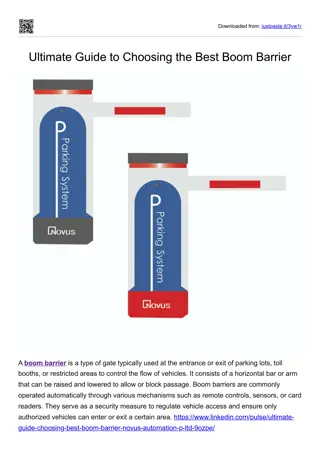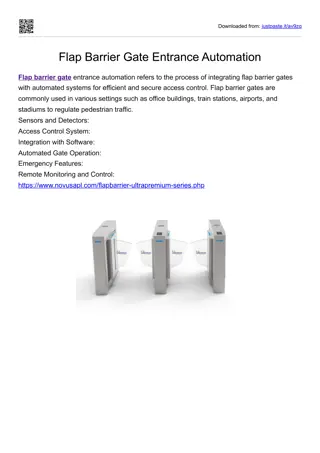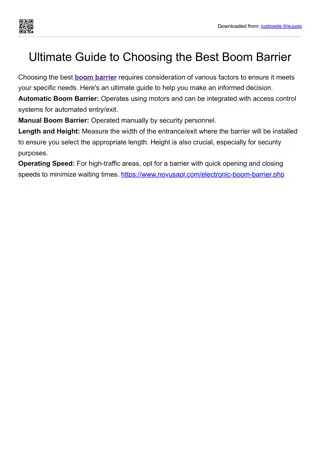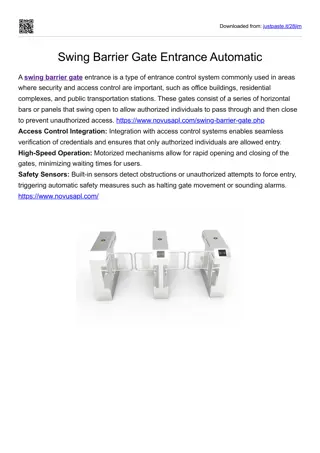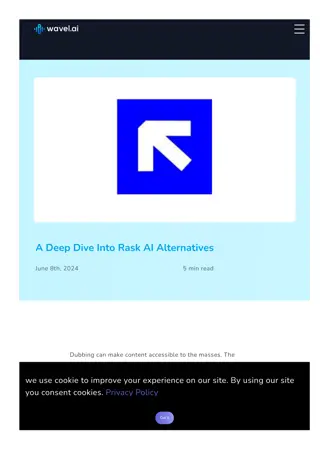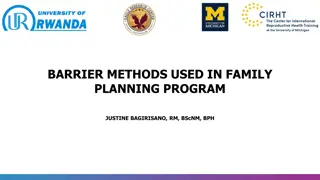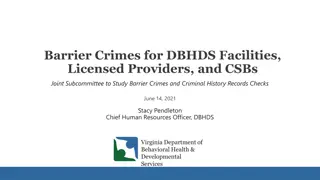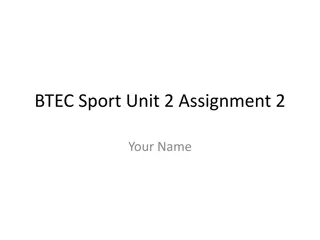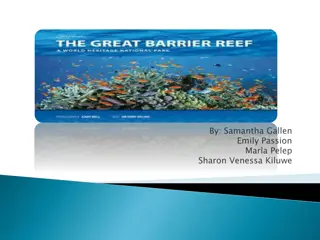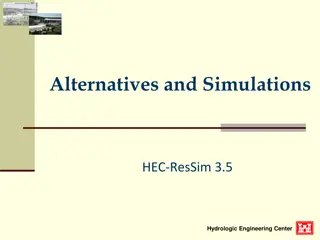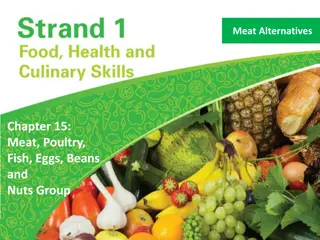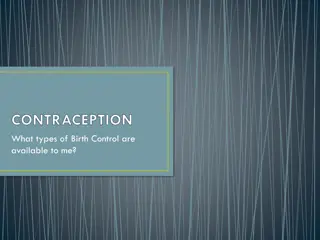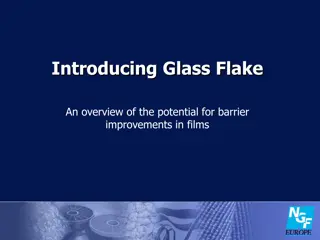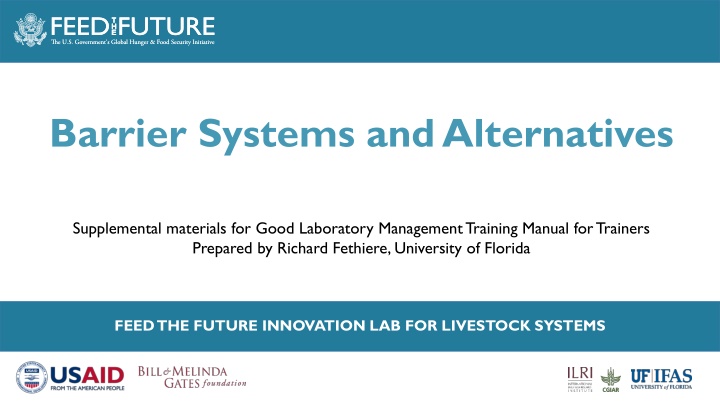
Effective Laboratory Facility Management Strategies
Explore supplemental materials on good laboratory management, focusing on facility setup, separation considerations, factors for building suitability, and activity-specific requirements like dose mixing units. Learn about physical and logistical separations, safety measures, and best practices for maintaining a conducive research environment.
Download Presentation

Please find below an Image/Link to download the presentation.
The content on the website is provided AS IS for your information and personal use only. It may not be sold, licensed, or shared on other websites without obtaining consent from the author. If you encounter any issues during the download, it is possible that the publisher has removed the file from their server.
You are allowed to download the files provided on this website for personal or commercial use, subject to the condition that they are used lawfully. All files are the property of their respective owners.
The content on the website is provided AS IS for your information and personal use only. It may not be sold, licensed, or shared on other websites without obtaining consent from the author.
E N D
Presentation Transcript
Barrier Systems and Alternatives Supplemental materials for Good Laboratory Management Training Manual for Trainers Prepared by Richard Fethiere, University of Florida FEED THE FUTURE INNOVATION LAB FOR LIVESTOCK SYSTEMS Photo Credit Goes Here
Resources: Facilities Adequate separation of facilities Factors to consider Background Pharmacy/chemicals Animal facilities Documentation for buildings
RESOURCES/FACILITIES: ADEQUATE SEPARATION Physical separation Separation (logistics) Defined work areas One-way systems Separate staff Rooms Cabinets/isolators Air systems and filters Different activities in same areas at different times Cleaning between activities
RESOURCES/FACILITIES: FACTORS TO CONSIDER Access / security Cleaning Storage Utilities and maintenance Waste disposal Staff safety and comfort Potential impact on the study Test systems Study types Number of studies Staff Operational Experimental
RESOURCES/BUILDINGS: IS IT ADEQUATE FOR THE STUDY? Examples Pharmacy and dose mixing unit Animal facilities
ACTIVITY: DOSE MIXING UNIT Resources/Buildings: Pharmacy and dose mixing unit Receipt Storage Deals with test and control items like: Dispatch Dispensing Mixing Weighing
RESOURCES/BUILDINGS Pharmacy and dose mixing unit: Toxic or corrosive chemicals Size Accommodates all activities (including paperwork) without task of mix-ups or cross contamination Enough working area, independent storage and waste disposal Construction Materials allow for easy cleaning Air flow/filters protect test items & personnel
RESOURCES/BUILDINGS: PHARMACY/CHEMICALS Location - Separate areas for Mixing different dose forms (e.g., Diet & liquid) Storage of test materials Storage of control materials Handling volatile materials Storage of prepared dose Weighing areas Cleaning equipment Offices toilets Changing rooms
RESOURCES/BUILDINGS: ANIMAL FACILITIES Design should Reduce risk of test system Being affected by environmental variables Encountering disease Encountering other test articles One answer: BARRIER SYSTEM
RESOURCES/BUILDINGS: ANIMAL FACILITIES Air pressure difference / airflow and filters Food (not contaminated) Water (clean supply) Temperature Bedding (dust free, autoclaved) Health Cages Noise status/Quarantine Dose mixing (pharmacy) Waste (prompt elimination)
RESOURCES/ BUILDINGS: ANIMAL FACILITIES Species Studies Necropsy Separation Storage: Bedding, diet, doses, cages Quarantine Changing rooms Material reception
RESOURCES/BUILDINGS: ANIMAL FACILITIES Environmental factors controlled Temperature/humidity Air flow Light (intensity, duration, etc.) Noise Cleaning Smooth, flat surfaces, walls, doors, ceilings No gaps, cracks, holes
RESOURCES/BUILDINGS: ANIMAL FACILITIES Even if facilities are not state of the art Minimize staff entry into building Restrict entry into animal rooms Organize workflow (use of corridors clean/dirty at different times) Require staff to adopt dress procedures Clean between studies
ACTIVITY: CASE STUDY ON CONTAMINATION/DISTURBANCE
RESOURCES/BUILDINGS: DOCUMENTATION FOR BUILDINGS Separation Standard Operating Procedures (SOP) Floor Plans Qualification report Logbook Service, maintenance reports Fault action report/errors/modifications/fixes
ACTIVITY: DISCUSSION ON GLP BUILDING COMPLIANCE
ACTIVITY: END OF DAY REFLECTION
Consult the Good Laboratory Management Training Manual for Trainers https://livestocklab.ifas.ufl.edu/resources/glp/ Direct link to manual in PDF: https://livestocklab.ifas.ufl.edu/media/livestocklabifasufledu/pdf- /MANUAL-Fethiere_UF_Good-lab-management-practices_2022.pdf
Feed the Future Innovation Lab for Livestock Systems https://livestocklab.ifas.ufl.edu/ (Subscribe to newsletter) livestock-lab@ufl.edu Disclaimer This work was funded by the United States Agency for International Development (USAID) Bureau for Food Security under Agreement #AID-OAA-L-15-00003 as part of Feed the Future Innovation Lab for Livestock Systems, and by the Bill & Melinda Gates Foundation OPP#1175487. Any opinions, findings, conclusions, or recommendations expressed here are those of the authors alone.



